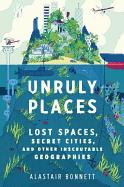
In Unruly Places, social-geography professor Alastair Bonnett (What Is Geography?; How to Argue) turns our explored, explained and digested world into unmapped possibilities. Bonnett opens the book with a promise to take readers to 47 of the world's most remarkable places, highlighting destinations both unusual and little-known, while examining what drives people to travel.
From the remains of places that no longer exist, to islands charted on maps (though they never actually existed), to fashionably and consciously constructed destinations of our present, Bonnett has organized the book in a way that mimics human exploration. Unruly Places is best enjoyed from start to finish, but true to the spirit of exploration, readers may begin at any point. For those who engage linearly, Bonnett develops a chronological story of exploration and colonization up to the present day, tying one destination to the next with unifying themes (loss, death and independence, to name a few).
Political, cultural and physical landscapes shape our understanding of geography. Our sense of place continues to be, in many ways, a projection of our desires, hopes and fears. Borders shift, names change, histories are forgotten, construction sites appear overnight, natural spaces are "museumified." In each case, the choices we make about our environments provide a cultural lens through which we interpret the world. Bonnett proposes that our need to explore "off the map" is our attempt to excise a shared emptiness, a hollow and homogenized sense of place in a world that is increasingly accessible and documented. --Justus Joseph, bookseller, Elliott Bay Book Company

